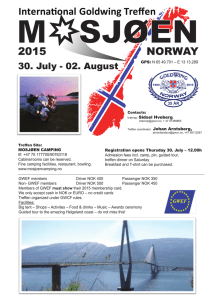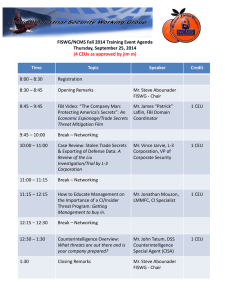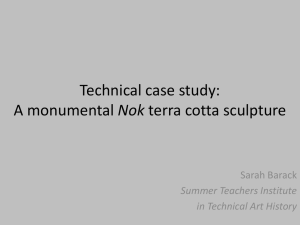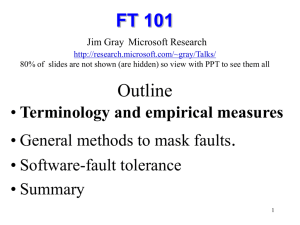Document
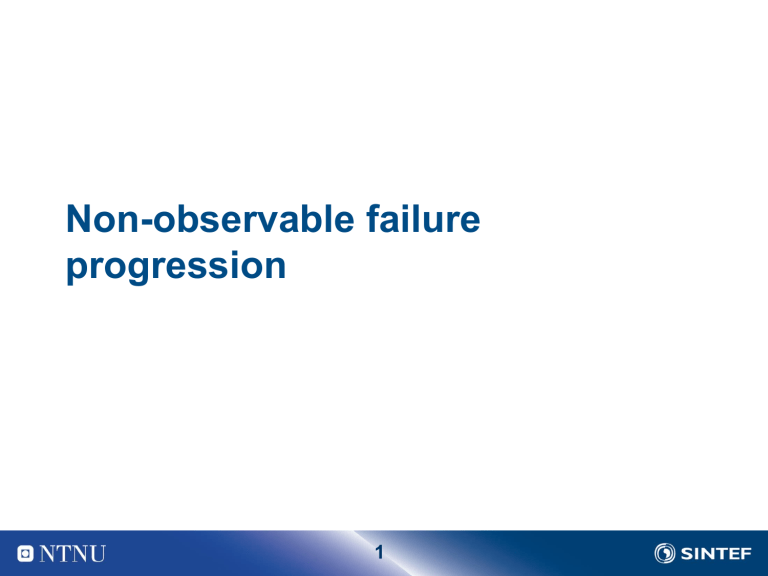
Non-observable failure progression
1
Age based maintenance policies
We consider a situation where we are not able to observe failure progression, or where it is impractical to observe failure progression:
Examples
Wear of a light bulb filament
Wear of balls in a ball-bearing
Result an increasing hazard rate z ( t )
t
t time, t
2
Weibull model
Hazard rate
z ( t ) = (
)(
t )
-1
t
-1
Re-parameterization introducing MTTF and aging parameter
z ( t ) = (
)(
t )
-1 =
[
(1+1/
)/MTTF ]
t
-1
Effective failure rate,
E
(
) , is the expected number of failures per unit time for a unit put into a “god as new” state each
time units
Assuming that only one failure could occur in [0,
>, the average “failure rate” is
E
(
) =
-1
0
[
(1+1/
)/MTTF ]
t
-1 dt = [
(1+1/
)/MTTF ]
-1
3
Weibull standard PM model
MTTF
WO
= Mean Time To Failure Without Maintenance
= Aging parameter
C
PM
= Cost per preventive maintenance action
C
CM
= Cost per corrective maintenance action
C
EU
= Expected total unavailability cost given a component failure
C
ES
= Expected total safety cost given a component failure
Total cost per unit time
C (
) = C
PM
/
+
E
(
) [ C
CM
+ C
EU
+ C
ES
]
4
Optimal maintenance interval
C (
) = C
PM
/
+
E
(
) [ C
CM
+ C
EU
+ C
ES
]
= C
PM
/
+ [
(1+1/
)/MTTF wo
]
-1 [ C
CM
+ C
EU
+ C
ES
]
C (
)/
= 0
MTTF
WO
C
PM
C
CM
C
EU
C
ES
(
1)
1/
5
Exercise
Prepare an Excel sheet with the following input cells:
MTTF
WO
= Mean Time To Failure Without Maintenance
= Aging parameter
C
PM
= Cost per preventive maintenance action
C
CM
= Cost per corrective maintenance action
C
EU
= Expected total unavailability cost given a component failure
C
ES
= Expected total safety cost given a component failure
Implement the formula for optimal maintenance interval
6
Exercise continued – Timing belt
Change of timing belt
MTTF
WO
= 175 000 km
= 3 (medium aging)
C
PM
= NOK 7 000
C
CM
= NOK 35 000
7
Exercise continued
Additional information
Pr(Need to rent a car|Breakdown) = 0.1
Cost of renting a car = NOK 5000
Pr(Overtaking |Breakdown) = 0.005
Pr(Collision|Overtaking |Breakdown)=0.2
C
Collision
= NOK 25 million
Find optimal interval
8
Age replacement policy- ARP
The age replacement policy (model) is one of the classical optimization models:
The component is replaced periodically when it reaches a fixed age
If the component fails within a maintenance interval, the component is replaced, and the “maintenance clock” is reset
Usually replace the component after a service time of
In some situations the component fails in the maintenance interval, indicated by the failure times T
1 and T
2 t = 0
T
1
T
2
Tid
9
ARP, steps in optimization
Assume all components are as good as new after a repair or a replacement
Usually we assume Weibull distributed failure times
Repair time could be ignored with respect to length of a maintenance cycle
The length of a maintenance cycle ( T
MC
) is a random quantity
E T
MC
)
0
T
( )d
Pr( T
)
0
1
F t
T
t
Effective failure rate
E
E (failure in the cycle)
E (Cycle length)
0
F
T
1
F t
T
t
10
ARP, cont
Rate of PM actions: 1/ E ( T
MC
)-
E
(
)
Cost model
C (
) = C
PM
[1/ E ( T
MC
)-
E
(
)] +
E
(
) [ C
CM
+ C
EU
where
+ C
ES
]
E T
MC
)
0
T
( )d
Pr( T
)
0
1
F t
t
E
0
F
T
1
F t
T
t
11
Exercise
Use the ARP.xls file to solve the “timing belt” problem with the ARP
Compare the expression for the effective failure rate with the “standard” Weibull model
12
Block replacement policy - BRP
The block replacement policy (BRP) is similar to the ARP, but we do not reset the maintenance clock if a failure occurs in a maintenance period
The BRP seems to be “wasting” some valuable component life time, since the component is replaced at an age lower than
if a failure occurs in a maintenance period
This could be defended due to administrative savings, or reduction of
“set-up” cost if many components are maintained simultaneously
Note that we have assumed that the component was replaced upon failure within one maintenance interval
In some situations a “minimal repair”, or an “imperfect repair” is carried out for such failures
T
1
T
2
Time t = 0
2
3
4
5
6
7
8
9
10
11
12
13
BRP – Steps in optimization
Effective failure rate
E
Where
W ( t ) is the renewal function
W
14
How to find the renewal function
Introduce
F
X
( x ) = the cumulative distribution function of the failure times
f
X
( x ) = the probability density function of the failure times
From Rausand & Høyland (2004) we have:
W ( t )
F
X
( t )
t
0
W ( t
u ) f
X
( u ) du
With an initial estimate W
0
( t ) of the renewal function, the following iterative scheme applies:
W i
( t )
F
X
( t )
t
0
W i
1
( t
u ) f
X
( u ) du
15
3 levels of precision
For small
E
(
< 0.1MTTF
(
) = [
(1+1/
)/MTTF wo
]
WO
-1
) apply:
For
up to 0.5MTTF
WO apply (Chang et al 2008)
E
MTTF
1
where the
() is a correction term given by
1
0.1
2
MTTF
2
(0.09
0.2)
MTTF
For
> 0.5MTTF
WO implement the Renewal function
16
BRP - Solution
Numerical solution by the Excel Solver applies for all precision levels
For small
(
< 0.1MTTF
WO
) we already know the analytical solution
For
up to 0.5MTTF
WO an analytical solution could not be found, but an iterative scheme is required (or “solver”)
For
> 0.5MTTF
(i.e.,
E
(
WO only numerical methods are available
) = W (
)/
)
17
BRP – Iteration scheme
Fix-point iteration scheme
i
1
MTTF
WO
(1 1 / ) [ C
PM
C
EU
C
ES
C
PM
] (
( , , MTTF i WO
)
i
'( , , MTTF ) i WO
Where
’ () is the derivative of the correction term:
0.2
MTTF
2
0.09
MTTF
0.2
18
MRP = Minimal repair strategy
Assume that time to first failure (TTFF) is Weibull distributed
Upon a failure, the item is repaired to “a bad as old” level
I.e., the repair (corrective task) will not influence the “failure rate ”
In such a model the failure rate is denoted ROCOF (Rate Of
Occurrence Of Failures)
ROCOF= w ( t ) = rate of failure for a system with (global) age t
W ( t ) is the expected number of failures in a time interval [ 0, 𝑡
A common model is the power law model , where 𝑤 𝑡 = 𝜆𝛽𝑡 𝛽−1 and 𝑊 𝑡 = 𝜆𝑡 𝛽
This corresponds to TTFF is Weibull distributed with aging parameter
19
Cost model
Cost elements
C
F
= Cost of failure, i.e., each time we do a minimal repair
C
R
= Cost of renewal (when our car is old, and we buy a new car)
= Renewal interval (i.e., interval between buying a new car)
Expected cost per unit time:
𝐶 𝜏 =
𝐶
R
+ 𝑊 𝜏 𝐶
F =
𝐶
R
+𝜆𝜏 𝛽
𝐶
F =
𝐶
R + 𝜆𝜏 𝜏 𝜏 𝜏
Taking derivative of C (
) wrt
gives 𝛽−1 𝐶
F
𝐶 ′ 𝜏 = −
𝐶
R 𝜏 2
+ 𝜆 𝛽 − 1 𝜏 𝛽−2 𝐶
F
= 0
1 𝛽
⇒ 𝜏 =
𝐶
R
λ(𝛽−1 𝐶
F
20
Shock model
Consider a component that fails due to external shocks
Thus, the failure times are assumed to be exponentially distributed with failure rate
Further assume that the function is hidden
With one component the probability of failure on demand,
PFD is given by PFD =
/2
The function is demanded by a demand rate f
D
21
Cost model
C
I
= cost of inspection
C
R
=cost of repair/replacement upon revealing a failure during inspection
C
H
= cost of hazard, i.e. if the hidden function is demanded, and, the component is in a fault state
Average cost per unit time:
C (
)
C
I
/
+ C
R
(
-
2
/2)+ C
H
/2
f
D
22
Cost model for kooN configuration
Often, the safety function is implemented by means of redundant components in a k oo N voting, i.e.; we need k out of N of the components to “report” on a critical situation
PFD for a k oo N structure is given by
PFD ≈
𝑁
𝑁 − 𝑘 + 1 𝜆𝜏
𝑁−𝑘+1
𝑁−𝑘+2
We may replace the
/2 expression with this expression for PFD in the previous formula for the total cost
In case of common cause failures, we add
/2 to the expression for PFD to account for common cause failures,
is the fraction of failures that are common to all components
23
How to calculate kooN
𝑥 𝑦 = 𝑥∙ 𝑥−1 ∙...∙(𝑥−𝑦+1
1∙2∙3∙⋯∙𝑦
For example
In MS Excel
5 𝑥
2
=
5∙4
1∙2
= 10 𝑦 = Combin(x, y
PFD=COMBIN(N,N-k+1)*((lambda*tau)^(N-k+1))/(N-k+2)
+ beta*lambda*tau/2
24
Exercise
We are considering the maintenance of an emergency shutdown valve
(ESDV)
The ESDV has a hidden function, and it is considered appropriate to perform a functional test of the valve at regular intervals of length
The cost of performing such a test is NOK 10 000
If the ESDV is demanded in a critical situation, the total (accident) cost is
NOK 10 000 000
Cost of repair is NOK 50 000
The rate of demands for the ESDV is one every 5 year. The failure rate of the ESDV is 2
10 -6 (hrs -1 )
Determine the optimum value of
by
Finding an analytical solution
Plotting the total cost as a function of
Minimising the cost function by means of numerical methods (Solver)
25
Exercise, continued
In order to reduce testing it is proposed to install a redundant ESDV
The extra yearly cost of such an ESDV is NOK 15 000
Determine the optimum test interval if we assume that the second ESDV has the same failure rate, but that there is a common cause failure situation, with
= 0.1
Will you recommend the installation of this redundant
ESDV?
26
Exercise, continued part 2
The failure rate of the ESDV equal to 2
10 -6 (hrs -1 ) is the effective failure rate if the component is periodically overhauled every 3 years
The aging parameter of the valve is
= 3
The cost of an overhaul is 40 000 NOK
Find out whether it pays off to increase the overhaul interval
Find the optimal strategy for functional tests and overhauls
27
Solution
Analytical solution, one valve: 𝜏 =
2𝐶
I 𝜆(𝑓
D
𝐶
H
−𝜆𝐶
R
28

